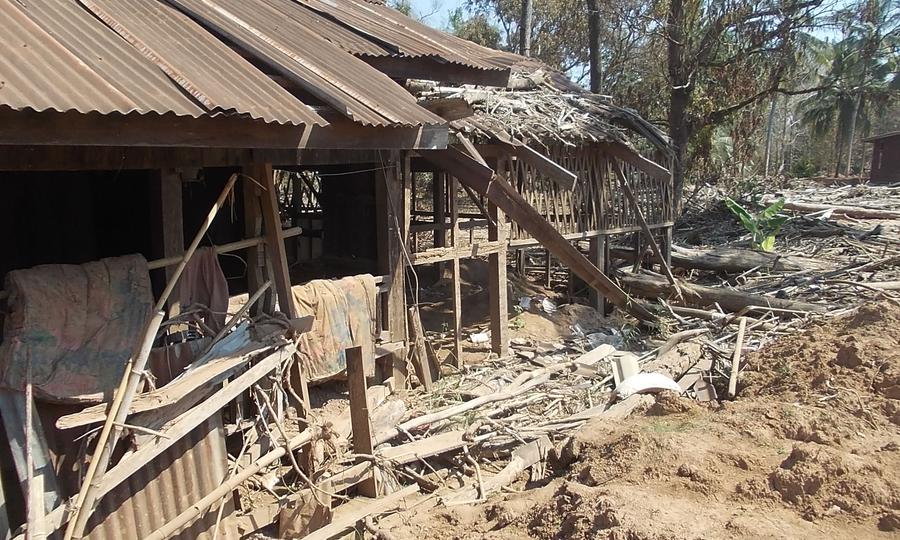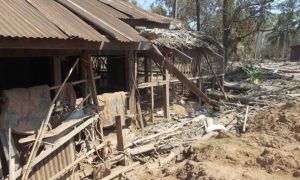
Major collapse on Laos dam last year, 70 people killed and many homeless – Civil society groups call for construction stop
Thousands of villagers who lost everything are stuck in camps in Attapeu and should get relief via insurance, activists say
Civil society groups in three countries have called for construction to stop on a dam in southern Laos where a major collapse occurred last year, killing more than 70 people and leaving about 5,000 villagers homeless.
The groups say thousands displaced by the disaster at the Xe-Pian Xe-Namnoy Dam one year ago are still stuck in temporary camps – living hand-to-mouth on meager rations and occasional daily allowances – and they must be helped before the project is completed.
“After surviving the loss of their homes, loved ones and farms, they are traumatized yet again by being denied adequate food, housing and dignity in the camps. Most are unable to return to their homes, and their futures remain highly uncertain,” the groups said in a statement.
Maureen Harris, Southeast Asian program director at International Rivers, said six main villages were inundated while a further 13 were hit by floodwater, including some 80km south over the border in northern Cambodia, where people’s crops and property were also destroyed. Thousands had yet to be compensated for property losses, and no one had been held accountable.
There is also concern that foreign experts who assessed the US$1-billion hydropower project in Sanamxai district in Attapeu province after the disaster expressed reservations about two other auxiliary dams at the site – that the structure of these ‘saddle dams’ could also be vulnerable as the wet season intensifies in coming weeks.
Korean building firm
A new report on the disaster, released in Bangkok on Tuesday by International Rivers and Inclusive Development International (IDI), said the panel of experts had given their technical feedback to the Lao government in March but it had not been released to the public. Lao government spokespeople have said the collapse was caused by “substandard construction” and that companies involved in the project would be held responsible for the damage and loss.
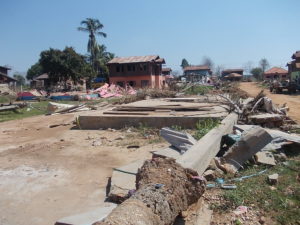
Fingers have been pointed at the Korean firm building the dam, SK Engineering & Construction, amid claims that it may have caused the collapse by cutting corners in a bid to maximize profits. Korean media have said that SK altered the design of the project, including lowering the walls of the saddle dam that collapsed to save millions of dollars.
Meanwhile, Richard Meehan, an engineer trained at Stanford University with expertise in dams on similar terrain in Southeast Asia, has claimed that the failed dam wall was built on soil that was highly porous and that the collapse occurred on a “sinkhole.”
Lao officials have repeated this assessment and said publicly that the disaster could not be considered a ‘force majeure’ or act of God, suggesting that construction problems were the primary cause of the collapse. SK has rejected this but given no other explanation.
‘Developers and governments must act’
But questions remain about oversight of the design, planning and implementation of the project by the Lao, Thai and Korean governments, as well as the three other firms involved – Korea Western Power, Thailand’s Ratchaburi Electricity Generating Holding and the Lao State Holding Enterprise, all of which had quarter shares in Xe Pian-Xe Namnoy.
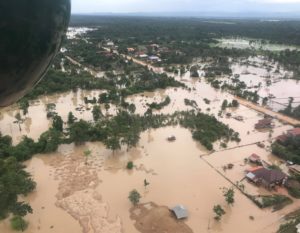
While the Lao government had ultimate authority to oversee the 410-megawatt power project, four Thai banks – Krung Thai Bank, Bank of Ayudhya (Krungsri), Thanachart Bank and the Export-Import Bank of Thailand – provided the bulk of the funding, US$714 million to build the dam, the groups said at their press conference.
The Asian Development Bank also played a behind-the-scenes role in moving the project forward, IDI’s Craig Bradshaw said.
However, the ADB disputed this, saying it did not act as a financial adviser for the project and that they withdrew from the project at “a relatively early stage as a result of our initial environmental and social due diligence.”
The Electricity Generating Authority of Thailand (Egat) signed a power purchase agreement in 2013 to take 90% of the dam’s electricity for a period of 27 years. And Egat is also the largest shareholder in Ratchaburi.
Liability insurance
Most importantly, policies for up to US$50 million in liability insurance were taken out by entities building the dam with AIG, Korean Re and Samsung Fire & Marine, Bradshaw said.
“There is a pot of insurance for people to claim for their losses,” he said. “Construction should halt until victims are effectively remedied. Developers are responsible to provide redress and to create a claims mechanism. This should be funded by financiers, insurers and electricity buyers.”
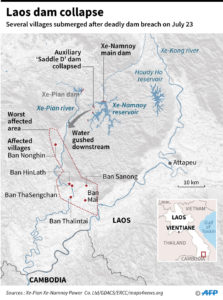
Activist Yun Jiyoung in Seoul spoke via video link to journalists in Bangkok last night, saying a task force had been set up because of the significant role that Korean companies and the Korean government had in the dam. She told of visiting Attapeu in January and finding villagers enduring a “very low quality of life … the camp conditions were very poor.”
The SK Group had not adequately explained the cause of the dam collapse and they “don’t provide transparent information,” she commented. “But we’ll make an effort to get to the truth.”
An official from the South Korean builder told AFP it was “willing to actively cooperate” once the Lao government investigation findings were released.
‘No chance for victims to speak out’
However, yesterday’s press conference was held in Bangkok because Laos is an authoritarian one-party state that frowns on outside scrutiny. Rights groups describe it as one of the world’s most repressive regimes. And the groups lobbying on behalf of the Lao dam victims said they were addressing the media in Thailand because there was little chance of the victims speaking out publicly in their homeland.
Harris and Bradshaw said lawyers saw no prospect of a compensation case being pursued through a court in Vientiane. They said it was far more likely that such cases would be pursued through the courts in Thailand and/or Korea if adequate compensation was not paid by SK Engineering and the other developers.
Harris said: “It is important to commend the Lao government for the independent investigation [into the dam collapse]. We are trying to put the spotlight on others and their roles [in the dam project].
“There is a need for Thailand to incorporate extra-territorial responsibilities from projects such as this involving Thai companies and government entities. They have made obligations under international rights agreements that should be adhered to.”
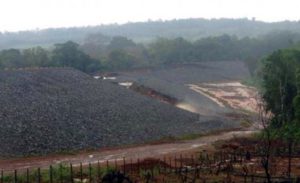
Laos, meanwhile, has insisted that its contentious hydropower strategy – to build hundreds of dams and become the “battery of Asia” – will continue.
‘Dams made to benefit the builders’
However, Thai environmentalist Premrudee Daoroung said last night the fact that dams in China and others now on the mid-section of the Mekong had reduced the river to a trickle – its lowest level in decades – showed that the policy was a social and environmental disaster.
“Laos has 63 dams already, with 27 coming along, and another 300+ planned. But the scenario we’re watching and seeing in Laos – they’re only protecting the private sector. And why does the Korean government have to do that? The flood went over a very large area.
“It’s a hide and seek game that has been played over the last year. There has been no report from the Lao government or the SK company. Nothing has come out from the company. Meanwhile, we have a drought on the Mekong. The Xayaburi Dam is creating a big drought.
“But China already controls the Mekong. And the dam builders they never take into account the risk of these dams – you can’t declare too much risk in a [dam] proposal. I don’t believe they will build the 500 dams [planned in Laos and Southeast Asia] or that the 12 on the lower Mekong will happen. Hydropower from Mekong dams is no longer feasible.”
She predicted that the disastrous impacts from the Xe-Pian Xe-Namnoy and other dams would soon become obvious to all, partly because local people would have to pay for the costs through their power bills.
For Harris, the Xe-Pian Xe-Namnoy tragedy had shown exposed how dam projects “are developed to benefit the companies that build and finance them, at the expense of the local people placed in harm’s way.
“But this tragedy demands an end to business-as-usual and commitment to building a development model that is just and sustainable for all. For too long, repeated warnings from scientists, communities and civil society have been disregarded.”
With reporting by AFP
Source: https://www.asiatimes.com/2019/07/article/stop-work-on-lao-dam-and-help-victims-groups/
